Fig. 1.1
Photomicrograph of primitive streak in the bilaminar germ disc. The primitive pit, primitive groove, and primitive node form the primitive streak. The head of the embryo will eventually form at the primitive pit and primitive node, and the entire structure (the primitive streak) establishes the embryonic longitudinal axis (Adapted from Tamarin (1983) With permission from John Wiley & Sons)
A three-layered embryo is formed by the proliferation and migration of epiblast cells through the primitive streak (Fig. 1.2a–c). Epiblast cells invade and replace the hypoblast cell layer, forming the definitive endoderm. Migration of epiblast cells between the epiblast and endoderm layers continues, forming a third cell layer, mesoderm. Upon establishment of the mesodermal layer, the epiblast is renamed the ectoderm or ectodermal layer.
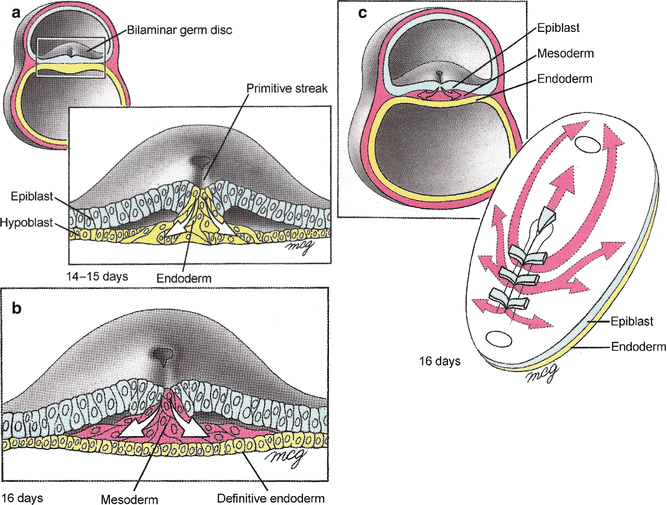

Fig. 1.2
(a–c) Proliferation and migration of epiblast cells. Epiblast cells proliferate and migrate through the primitive streak eventually forming the endoderm, mesoderm, and ectoderm; the definitive three-cell layered embryo (Adapted from Larsen (1993). With permission from Elsevier)
Two midline structures develop in the mesoderm: the prechordal plate and the notochordal process. The notochordal process begins as a hollow mesodermal tube and goes on to become a solid rod structure, called the notochord. The notochord induces the formation of the vertebral bodies, and subsequently, the vertebral bodies coalesce around the notochord inducing the notochord to form the nucleus pulposus (Fig. 1.3a, b).
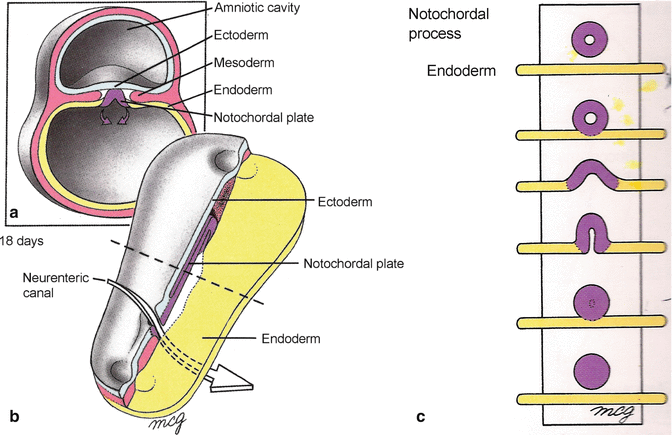

Fig. 1.3
(a–c) Formation of the notochordal process and notochord. The hollow notochordal process forms within the mesoderm and goes on to form the solid notochord. The notochord induces vertebral body formation and eventually becomes the nucleus pulposus (Adapted from Larsen (1993). With permission from Elsevier)
Following the development of notochord, three distinct structures form in the mesoderm: the paraxial mesoderm, intermediate mesoderm, and lateral plate mesoderm. As pertains to the spine and spinal cord, the paraxial mesoderm, which lies adjacent to the notochord, gives rise to cell lines that form the critical structures called the somites. The somites are responsible for formation of the axial skeleton, voluntary musculature, and the skin dermis (Fig. 1.4). The intermediate mesoderm and lateral mesoderm are involved in the development of the urogenital and cardiopulmonary systems. As a consequence, defects that alter the development of the mesoderm resulting in vertebral abnormalities may also result in concurrent abnormalities in the urogenital and cardiopulmonary systems. VACTERL syndrome is an acronym with each letter representing an associated defect secondary to abnormalities in the mesodermal development including Vertebral anomalies, imperforate Anus, Cardiac abnormalities, TracheoEsophageal fistula, Renal dysplasia, and Limb malformations. Approximately 30–60 % of vertebral abnormalities diagnosed in childhood will have an additional organ system abnormality, with the genitourinary system most commonly involved. This underscores the need to evaluate for additional organ system involvement in children and infants with congenital vertebral abnormalities, including cardiac and renal ultrasound.
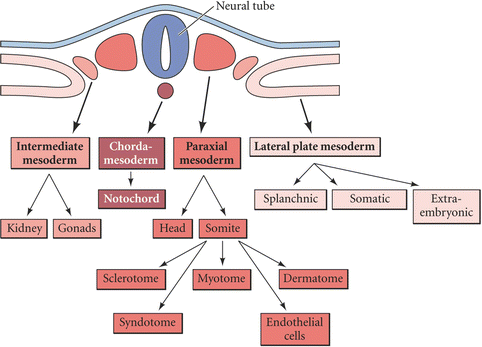

Fig. 1.4
Paraxial mesoderm, intermediate mesoderm, and lateral plate mesoderm formation, location and eventual structures (Adapted from Larsen (1993). With permission from Elsevier)
1.2 Somite Formation and Differentiation
The axial skeleton, voluntary muscle, and the dermis of the neck and trunk are derived from the somites. The somites emerge as paired on approximately gestational day 20, arising from the paraxial mesoderm and developing in a cranial to caudal fashion at a rate of approximately 3–4 somites per day (Fig. 1.5).Initially 42–44 somite pairs exist adjacent to the notochord. The cranial-most somite pairs eventually form the base of the skull and extend caudally to a rudimentary structure, the embryonic tail. However, caudal 5–7 somites regress, leaving a total of 37 somite pairs for development. Somite pairs 1–4 form the occiput as well as the bones of the face and inner ear. Somites 5–12 form the cervical spine (there are eight cervical somites but ultimately only seven cervical vertebrae because the first cervical somite participates in occiput formation). Somites 13–24 form the thoracic vertebrae, somites 25–29 form the lumbar vertebrae, and somites 30–34 form the sacral vertebrae. The remaining three terminal somite pairs form the coccyx and persist after regression of the terminal embryonic tail. The consecutive somite pairing on the embryo creates an anatomic template that organizes the vertebral alignment and the corresponding peripheral nervous system (PNS), which persists to maturity.
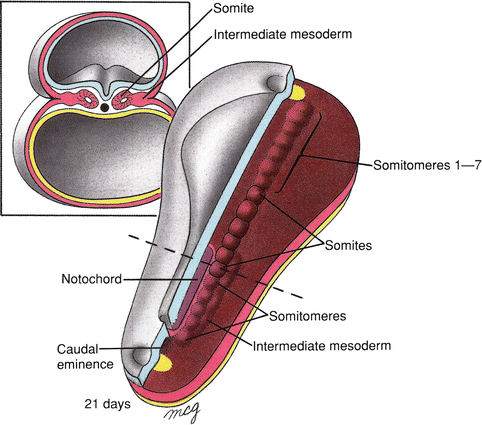

Fig. 1.5
Somite formation. The paired somites arise from the paraxial mesoderm and form the axial skeleton, voluntary muscle, and the dermis of the neck and trunk (Adapted from Larsen (1993). With permission from Elsevier)
As the embryo develops, the somites separate into subdivisions. Accordingly, the ultimate tissue structure that develops from each somite is produced from the respective somite subdivision. The first somite subdivision that appear are the sclerotomes. The sclerotomes ultimately give rise to the bony spinal column. Sclerotomes are formed when a hollow central cavity forms within the somite. This cavity develops in the medial region of the somite adjacent to the midline notochord and neural tube. The central cavity fills with cells, termed loose core cells, and eventually ruptures, allowing the core cells to migrate toward the midline and envelop the notochord and neural tube (Fig. 1.6). The cellular structure that eventually surrounds the notochord and neural tube is termed sclerotome. The ventral sclerotome that surrounds the notochord eventually becomes the vertebral body, and the dorsal sclerotome that envelops the neural tube eventually becomes the vertebral arch.
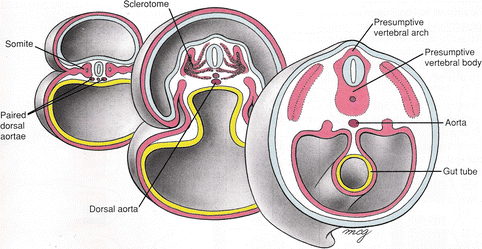

Fig. 1.6
Sclerotome formation. The central cavity within the somite fills with loose core cells and eventually ruptures. Core cells migrate toward the midline and envelop the notochord and neural tube forming a sclerotome. The ventral sclerotome forms the vertebral body, and the dorsal sclerotome becomes the vertebral arch (Adapted from Larsen (1993). With permission from Elsevier)
Normal vertebral body and vertebral arch development are dependent upon sclerotome induction by the underlying notochord and neural tube. Abnormalities in this sclerotomal-notochord induction signaling process creates spinal dysraphism, which is a spectrum of birth defects caused by failure of neural tube closure. Spina bifida is defined as incomplete closure of the neural arch leaving the underlying neural elements uncovered. The severity of spina bifida ranges from spina bifida occulta, in which the neural arch fails to completely close, to more severe conditions of spina bifida, in which the contents of the neural canal extend out of the canal and become continuous with the overlying skin. The type and severity of spina bifida are classified by the neurological tissue that extends out of the canal, which may include the neural meninges (dura and arachnoid), as well as nerve roots. The neurological tissue that extends out of the spina bifida defect is contained within a membranous tissue called a cele. The cele is what is visible on the skin surface overlying the spina bifida defect and, as indicated above, may contain meningeal tissue, in which case, the cele is termed a meningocele. The cele may also contain neural tissue and meninges, called a meningomyelocele.
Stay updated, free articles. Join our Telegram channel

Full access? Get Clinical Tree








